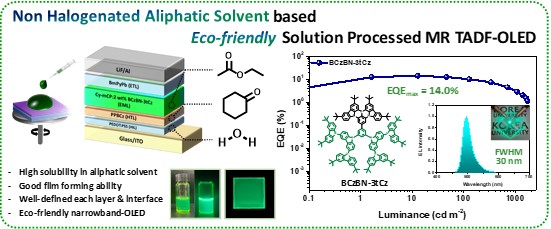In general, fabricating multilayer structures in solution-processed organic light-emitting diodes (OLEDs) presents challenges owing to the potential degradation of the initial film during subsequent processing steps. Furthermore, these devices typically require aromatic and halogenated solvents recognized for their adverse effects on human health and their harmful environmental impact. In this study, we successfully synthesized a solution-processable multi-resonance thermally activated delayed fluorescence (MR-TADF) emitter by introducing tert-butyl carbazolyl dendron, which exhibits excellent solubility. In our approach, we fabricated a multilayer OLED for solution processing utilizing eco-friendly, non-halogenated aliphatic solvents, with each layer in the devices developed utilizing water, cyclohexanone, and ethyl acetate for the hole injection layer, hole transport layer, and emitting layer, respectively. The resulting eco-friendly solution-processed OLED achieved a maximum external quantum efficiency (EQEmax) of 14.0 % and a narrow bandwidth of 30 nm. Furthermore, utilizing an additional TADF sensitizer led to a remarkable EQEmax enhancement of over 15 % and a substantial improvement in efficiency roll-off. Thus, the eco-friendly device fabrication strategy employed here opens novel avenues for diverse research in organic semiconductor devices that must be fabricated with solution processes in the future.

https://doi.org/10.1016/j.cej.2023.148484
 Self-Aggregating Tau Fragments Recapitulate Pathologic Phenot...
Self-Aggregating Tau Fragments Recapitulate Pathologic Phenot...


















